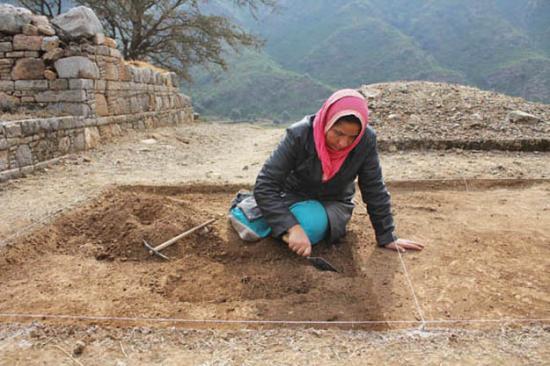Hidayat Khani
Source - http://tribune.com.pk/story/773466/the-dreamcatchers-archaeologists-strike-the-spade-to-unravel-bhamalas-secrets/

The site at Bhamala Buddhist Archaeological Complex, a Buddhist stupa 25 kilometres from Taxila Museum in Khanpur. PHOTO: HIDAYAT KHAN/EXPRESS
Archaeologists find it difficult to conduct fieldwork in Khyber-Pakhtunkhwa (K-P). The stakes are high as law and order in the province remains volatile. However, archaeologists have proven these refrains to be more the static stereotypes than an actual obstacle. Recent fieldwork provides welcome proof of this fact.
The Archaeological Research and Conservation Program India and Pakistan (ARCPIP) has completed a two-year field study of the Bhamala Buddhist Archaeological Complex, a Buddhist stupa 25 kilometres from Taxila Museum in Khanpur.

An archaeologist at work. PHOTO: HIDAYAT KHAN/EXPRESS
In these two years, the ARCPIP team excavated 5% of the site, altogether leaving 60% of it uncovered. Even though only 40% of the Bhamala site is exposed, as stated in a report by Dr Abdul Samad who participated in this study and is the director of archaeology in Khyber-Pakhtunkhwa, ARCPIP project’s findings will help with current limitations in the understanding of both archaeological and historical aspects of the site.
One of the ARCPIP study’s main aims, stated the report, was to find evidence for a range of periods to start to construct a chronology for the settlement and identify the “broad character of the Buddhist settlement in this remote valley.” And according to both the report and the director who spoke to The Express Tribune, the fieldwork has yielded in evidence to start constructing the said chronology.
Samad’s paper added that the project examined cultural developments in “Buddhist archaeology in the subcontinent, looked into its impact and connections with its border regions, such as greater Gandhara and Kashmir Valley, the spread of Buddhism, and Buddhist art and architecture in and around Taxila.”
Beneath the surface
Sir John Marshall struck the first spade between 1929 and 1931 to uncover the secrets of the site. Early excavation work by Marshal exposed the Buddhist Stupa and parts of a monastery. The new project builds on earlier studies and draws attention to fresh insights and discoveries.
“We have discovered evidence of past settlements on the site,” said Samad, who represented Hazara University for the purpose of this study. “According to our team of experts, Bhamala was used by Buddhists hundreds of years ago; this is the first time an archaeologist can definitively say this.”

Brushing the head of a statue clean. PHOTO: HIDAYAT KHAN/EXPRESS
The extension of the site along its western wing provides concrete evidence of another phase of settlement. It suggests settlers used to regularly move to and from Bhamala.
The team found several relics during the excavation work. A carnelian seal, depicting what could possibly be the deity Gajalakshmi (one of the eight aspects of Ashta Lakshmi, the Hindu goddess), was discovered. Furthermore, the discovery of strong evidence of Kashmiri influences in the artefacts has added a new dimension to Buddhist ideology in the region.
Several terracotta and stucco Buddha statues and copper coins were also recovered from the site. These date back to the Kidara-Kushan period (4 to 5 CE).
“The chronology—which goes beyond Kushan period (2CE)—indicates Bhamala was not isolated from main Taxila,” Samad said.
“On the contrary, material found in Bhamala can be used to find answers to the innumerable questions about the change in Buddhist culture, development and contact in this region which have remained unanswered.”
Going modern
According to Samad, the Harris Matrix technique has been used for the first time instead of the conventional Wheeler and Marshall techniques usually applied in archaeology in Pakistan. Pakistani students have also been trained by expert archaeologists, he added.
Occupational hazards
According to Samad, security was not a major concern. “Bhamala is a peaceful place,” he said. “Therefore, archeologists did not face security threats which have plagued the entire country.” He added, this allowed the team to focus on field strategies.
The ease with which the Bhamala study took place is also an encouraging sign for archaeologists from across the world whose fieldwork has been curtailed by security issues over the last few years. “We are planning to extend the scope of our research and undertake more excavation work in the area.”
The bigger problems faced by the team were visa issues, prompting them to arrange conferences at alternative venues instead of India.